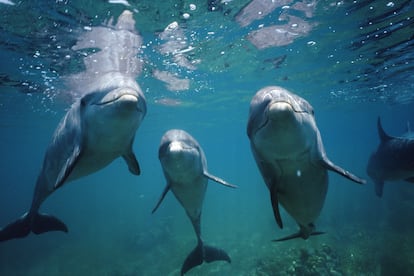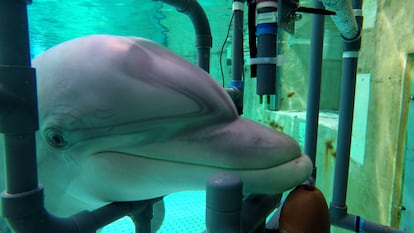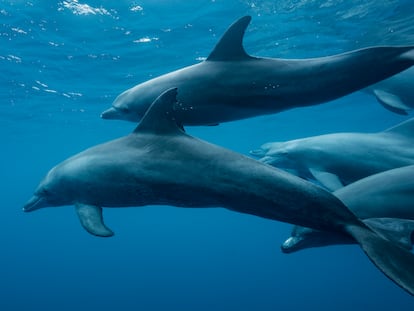Bottlenose dolphins have a seventh sense: They can feel electricity
These aquatic mammals use electric fields to locate prey hidden at the bottom of the sea

Dolphins are among the few mammals that have six senses. In addition to taste, smell, hearing, sight and touch, they have the sense of echolocation: the sound waves they produce bounce off objects in the water, which allows them to detect even a small fish more than 300 feet away. Now, a series of experiments has confirmed that the bottlenose dolphin (Tursiops truncatus) — the most commonly found in aquariums — has a seventh sense: it is capable of detecting electric fields, an ability that would help it hunt fish that hide at the bottom of the sea. The researchers also believe that this electroreception helps them orient themselves following the Earth’s magnetic field.
Although many fish, especially elasmobranchs (rays and sharks), and some amphibians can detect low-intensity electric fields, this is extremely rare among mammals. So rare, that only two of the most unusual animals on the planet have this ability: the platypus and the Australian echidna, both monotremes that lay eggs and have a single opening, the cloaca, where the digestive, urinary and reproductive tracts converge. In 2011, a group of German scientists discovered that the Guiana dolphin, a species of odontocete cetacean, perceived electrical signals. This dolphin, native to the American South Atlantic, from the Caribbean to the coasts of Brazil, hunts the fish that hide on or under the sand at the bottom of the sea. Now, part of the team that made that discovery has confirmed that bottlenose dolphins also have this ability.
The Guiana dolphin’s electroreceptive abilities led Guido Dehnhardt, the director of the Marine Science Center of the University of Rostock (Germany), to think that other dolphins could have this seventh sense, too. Dehnhardt, one of those responsible for the 2011 discovery, was convinced that bottlenose dolphins must also have this skill. “Both species follow a benthic feeding strategy,” he explains via email. This means that both eat fish that live at the bottom of the ocean. So, if the Guiana dolphin is capable of detecting the electricity generated by fish, why wouldn’t the bottlenose dolphin be able to do it too?

All living organisms generate electric fields around their bodies when they are in the water. That is the signal that dolphins detect. Tim Hüttners, Dehnhardt’s student, explains it: “These electric fields are generated by neuronal activity or muscle movement.” Fish also generate a field around them when the mucous membranes of their mouth and gills “come into direct contact with the ocean and release ions into the surrounding water.” Water, thanks to the salt it contains, helps spread these fields, which can be detected by those animals that have developed systems to perceive them. Sharks owe their short-range success to this (for long distances they use their sense of smell).
To verify the existence of this sense in bottlenose dolphins, Hüttners and Dehnhardt recruited Donna and Dolly, two females of this species that live in the Nuremberg aquarium. They created a system in which they had to touch a ball when they detected an electric field; if they got it right, they were rewarded with a herring. The experiments, carried out during the last three years and whose results were recently published in the Journal of Experimental Biology, showed that both had great sensitivity to electric fields. Although with some differences between the two, they felt fields generated with both alternating and direct current. To measure the scope, the researchers started with a field with an electrical potential of 500 microvolts per centimeter (μV/cm) and then they reduced it.
Donna and Dolly were equally sensitive to the stronger fields. With the moderate ones, the percentage of success was always above 80%. Only with the weakest electric fields Donna proved to be slightly more sensitive, detecting fields of 2.4 μV/cm, while Dolly perceived fields of 5.5 μV/cm. A microvolt is equivalent to one millionth of a volt. For comparison, platypuses, which also feed on animals that hide at the bottom (of rivers, in their case), capture crabs, shrimp or insects that reveal themselves with electric fields of 25 to 50 microvolts.
The seventh sense of these dolphins seems to be found in sensors that are reminiscent of the whiskers of cats or seals. “At birth, they still have follicles with hairs that function as mechanoreceptors (tactile information), but they lose the hair shortly after birth, and only empty crypts remain,” explains Hüttners. For a long time it was thought that those holes above the snout were vestiges of the past that had lost their function. But nothing could be further from the truth: “According to our tests and a previous study with a Guiana dolphin, the vibrissal crypts transform from a mechanoreceptor to an electroreceptor,” he explains.
Just by contracting their muscles or exchanging ions with water, aquatic animals generate fields of between 50 and 500 μV/cm. Although the authors of the study did not use live fish for their experiments, they believe that electroreception is key for dolphins to feed. These animals have echolocation capabilities, but when they are inches away from a hidden prey, the sand interferes with the echo signal. However, although the electric field weakens with distance, in close proximity it reveals the prize.
The biologists also mention a second function of this seventh sense, with the nerve endings in those crypts on the snout acting as a kind of magnetometer. “Electric and magnetic fields are always connected,” points out Hüttners. When a conducting body moves through a magnetic field, it generates an electric field. “This is called electromagnetic induction and it is present in sharks, and possibly in dolphins,” explains the researcher. As they swim through the Earth’s magnetic field, they generate an electric field around their body. “This electric field could be strong enough to be detected by the animal itself, providing information akin to a map that it can use to orient itself in the ocean,” concludes Hüttners. This would help explain the incidence of cetacean strandings after a solar storm or a magnetic anomaly.
The main goal of these experiments with bottlenose dolphins was to demonstrate that “electroreception doesn’t just occur in one species; it is probably an ability of perhaps the majority of toothed whales,” says Dehnhardt, senior author of this study. The problem is going to be verifying it, although there are some clues that it is true. This is the case of sperm whales, which are also odontocete cetaceans, in addition to the heaviest animal on the planet. Dehnhardt explains that these marine giants used to die by the dozens, caught in underwater cables; like the dolphins, they also feed on benthic fish and, in their search, they came across the cables, breaking more than one. However, in recent decades, no more deaths of this kind have been reported. The explanation could be, according to the German scientist, “a first indication of the ability of these odontocetes to perceive electric fields.” Early telegraph, and later, telephone systems, used metal-core cables that generated powerful electromagnetic fields, which could have attracted electroreceptive whales. However, neither coaxial cables nor optical fiber generate those fields, which is why sperm whales no longer have that problem.
Sign up for our weekly newsletter to get more English-language news coverage from EL PAÍS USA Edition










































